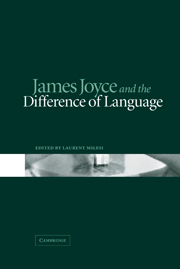Book contents
- Frontmatter
- Contents
- List of contributors
- Acknowledgements
- List of abbreviations
- Chapter 1 Introduction: language(s) with a difference
- Chapter 2 Syntactic glides
- Chapter 3 ‘Cypherjugglers going the highroads’: Joyce and contemporary linguistic theories
- Chapter 4 Madonnas of Modernism
- Chapter 5 Theoretical modelling: Joyce's women on display
- Chapter 6 The lapse and the lap: Joyce with Deleuze
- Chapter 7 ‘sound sense’; or ‘tralala’ / ‘moocow’: Joyce and the anathema of writing
- Chapter 8 Language, sexuality and the remainder in A Portrait of the Artist as a Young Man
- Chapter 9 Border disputes
- Chapter 10 Errors and expectations: the ethics of desire in Finnegans Wake
- Chapter 11 Ex sterco Dantis: Dante's post-Babelian linguistics in the Wake
- Chapter 12 No symbols where none intended: Derrida's war at Finnegans Wake
- Works cited
- Index
Chapter 8 - Language, sexuality and the remainder in A Portrait of the Artist as a Young Man
Published online by Cambridge University Press: 22 September 2009
- Frontmatter
- Contents
- List of contributors
- Acknowledgements
- List of abbreviations
- Chapter 1 Introduction: language(s) with a difference
- Chapter 2 Syntactic glides
- Chapter 3 ‘Cypherjugglers going the highroads’: Joyce and contemporary linguistic theories
- Chapter 4 Madonnas of Modernism
- Chapter 5 Theoretical modelling: Joyce's women on display
- Chapter 6 The lapse and the lap: Joyce with Deleuze
- Chapter 7 ‘sound sense’; or ‘tralala’ / ‘moocow’: Joyce and the anathema of writing
- Chapter 8 Language, sexuality and the remainder in A Portrait of the Artist as a Young Man
- Chapter 9 Border disputes
- Chapter 10 Errors and expectations: the ethics of desire in Finnegans Wake
- Chapter 11 Ex sterco Dantis: Dante's post-Babelian linguistics in the Wake
- Chapter 12 No symbols where none intended: Derrida's war at Finnegans Wake
- Works cited
- Index
Summary
A few pages into A Portrait of the Artist as a Young Man, the young Stephen Dedalus – not yet seven years old, if we can extrapolate from Joyce's own life – gives grave consideration to a word he has just heard from the mouth of one of his schoolfellows:
Suck was a queer word. The fellow called Simon Moonan that name because Simon Moonan used to tie the prefect's false sleeves behind his back and the prefect used to let on to be angry. But the sound was ugly. Once he had washed his hands in the lavatory of the Wicklow Hotel and his father pulled the stopper up by the chain after and the dirty water went down through the hole in the basin. And when it had all gone down slowly the hole in the basin had made a sound like that: suck. Only louder.
(1.150)From the point of view of modern linguistics, Stephen's theorizing is obviously false: ugliness does not inhere in the sounds of a language, and although a culture can imbue certain sounds with negative associations, none of the three common phonemes in ‘suck’ is so affected. (Compare the same sounds in words like ‘luck’, ‘sup’, ‘musk’, and ‘success’.) Nor would water going down a drain sound, in objective, measurable terms, like the word ‘suck’ uttered in any normal human voice or accent.
- Type
- Chapter
- Information
- James Joyce and the Difference of Language , pp. 128 - 141Publisher: Cambridge University PressPrint publication year: 2003
- 2
- Cited by



